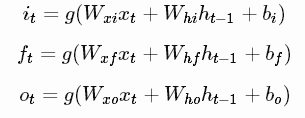In this tutorial, we will use tensorflow to build our own LSTM model, not use tf.nn.rnn_cell.BasicLSTMCell(). You can create a customized lstm by it.
LSTM Model
The structure of a lstm likes:

It contains three gats, they are:

To know more about lstm, you can read:
Understand Long Short-Term Memory Network(LSTM) – LSTM Tutorial
How to build our own LSTM Model
We will create a LSTM class with tensorflow. Here is full example code.
#file name: lstm.py
import tensorflow as tf
import numpy as np
class LSTM():
'''
num_emb: word embeddings dim, such as 200
inputs: batch_size * time_step * dim
'''
def __init__(self,inputs, emb_dim, hidden_dim, sequence_length):
self.emb_dim = emb_dim
self.hidden_dim = hidden_dim
self.sequence_length = sequence_length
self.batch_size = tf.shape(inputs)[0]
self.inputs = tf.transpose(inputs, perm=[1, 0, 2])
with tf.variable_scope('lstm_init'):
self.g_recurrent_unit = self.create_recurrent_unit() # maps h_tm1 to h_t for generator
self.g_output_unit = self.create_output_unit() # maps h_t to o_t (output token logits)
x0 = tf.nn.embedding_lookup(self.inputs,0)
# Initial states, such as 100 * 200
self.h0 = tf.zeros([self.batch_size, self.hidden_dim])
self.h0 = tf.stack([self.h0, self.h0])
gen_o = tf.TensorArray(dtype=tf.float32, size=self.sequence_length,
dynamic_size=False, infer_shape=True)
#x_t is current input, h_tm1 is hidden output of last cell
def _g_recurrence(i, x_t, h_tm1, gen_o):
h_t = self.g_recurrent_unit(x_t, h_tm1)
o_t = self.g_output_unit(h_t) # batch x 200
gen_o = gen_o.write(i, o_t)# save each hidden output
i_next = tf.where(tf.less(i, self.sequence_length-1), i+1, self.sequence_length-1)
x_t_next = tf.nn.embedding_lookup(self.inputs,i_next) #batch x emb_dim
return i+1, x_t_next, h_t, gen_o
#loop
i_l, _, h_l_t, self.gen_o = tf.while_loop(
cond=lambda i, _1, _2, _3: i < self.sequence_length, # stop condition
body=_g_recurrence,
loop_vars=(tf.constant(0, dtype=tf.int32), #start condition
tf.nn.embedding_lookup(self.inputs,0),
self.h0, gen_o))
self.gen_o = self.gen_o.stack() # seq_length x batch_size
self.gen_o = tf.transpose(self.gen_o, perm=[1, 0, 2]) # batch_size x seq_length * 200, output
# initialize matrix
def init_matrix(self, shape):
return tf.random_normal(shape, stddev=0.1)
# initialize vector
def init_vector(self, shape):
return tf.zeros(shape)
def create_recurrent_unit(self):
# Weights and Bias for input and hidden tensor
# input gate
self.Wi = tf.Variable(self.init_matrix([self.emb_dim, self.hidden_dim]), name = 'input_gate_wi')
self.Ui = tf.Variable(self.init_matrix([self.hidden_dim, self.hidden_dim]), name = 'input_gate_ui')
self.bi = tf.Variable(self.init_matrix([self.hidden_dim]), name = 'input_gate_bias')
# forget gate
self.Wf = tf.Variable(self.init_matrix([self.emb_dim, self.hidden_dim]), name = 'forget_gate_wf')
self.Uf = tf.Variable(self.init_matrix([self.hidden_dim, self.hidden_dim]), name = 'forget_gate_wf')
self.bf = tf.Variable(self.init_matrix([self.hidden_dim]), name = 'forget_gate_bias')
# ouput gate
self.Wog = tf.Variable(self.init_matrix([self.emb_dim, self.hidden_dim]), name = 'output_gate_wo')
self.Uog = tf.Variable(self.init_matrix([self.hidden_dim, self.hidden_dim]), name = 'output_gate_uo')
self.bog = tf.Variable(self.init_matrix([self.hidden_dim]), name = 'output_gate_bias')
# control gate
self.Wc = tf.Variable(self.init_matrix([self.emb_dim, self.hidden_dim]), name = 'control_gate_wc')
self.Uc = tf.Variable(self.init_matrix([self.hidden_dim, self.hidden_dim]), name = 'control_gate_uc')
self.bc = tf.Variable(self.init_matrix([self.hidden_dim]), name = 'control_gate_bias')
# a lstm unit, x is input, hidden_memory_tm1 is output of last cell, it contians two part (output, state)
def unit(x, hidden_memory_tm1):
previous_hidden_state, c_prev = tf.unstack(hidden_memory_tm1) # get output and state of last cell
# Input Gate
i = tf.sigmoid(
tf.matmul(x, self.Wi) +
tf.matmul(previous_hidden_state, self.Ui) + self.bi
)
# Forget Gate
f = tf.sigmoid(
tf.matmul(x, self.Wf) +
tf.matmul(previous_hidden_state, self.Uf) + self.bf
)
# Output Gate
o = tf.sigmoid(
tf.matmul(x, self.Wog) +
tf.matmul(previous_hidden_state, self.Uog) + self.bog
)
# New Memory Cell
c_ = tf.nn.tanh(
tf.matmul(x, self.Wc) +
tf.matmul(previous_hidden_state, self.Uc) + self.bc
)
# Final Memory cell
c = f * c_prev + i * c_
# Current Hidden state
current_hidden_state = o * tf.nn.tanh(c)
# output
return tf.stack([current_hidden_state, c])
return unit
#output of each lstm unit, you can customize it
def create_output_unit(self):#, params:
def unit(hidden_memory_tuple):
hidden_state, c_prev = tf.unstack(hidden_memory_tuple)
return hidden_state#logits
return unit
There are some poits you should notice:
1. Set initial output and state
We set both of them are 0, you can customize them.
# Initial states, such as 100 * 200
self.h0 = tf.zeros([self.batch_size, self.hidden_dim])
self.h0 = tf.stack([self.h0, self.h0])2. tf.while_loop() is the main of lstm
To know more tf.while_loop(), you can read:
Understand TensorFlow tf.while_loop(): Repeat a Function – TensorFlow Tutorial
3. We use a tensorarray to save the output and state of each lstm cell, you should notice:
gen_o = tf.TensorArray(dtype=tf.float32, size=self.sequence_length,
dynamic_size=False, infer_shape=True)
dynamic_size=False, it means gen_o is a fixed size tensorarray, meanwhile, it only can be read once.
You can read more on tensorarray.
Understand TensorFlow TensorArray: A Beginner Tutorial – TensorFlow Tutorial
4. If you want to add more gates or modify lstm gates, you can do it in unit(x, hidden_memory_tm1) function.
5. If you plan to modify the output of each lstm unit, you can edit create_output_unit(self) function.
How to use this model?
Here is an example:
custom_lstm = lstm.LSTM(x_shape, emb_dim =input_size, hidden_dim = hidden_dim, sequence_length = time_step) output = custom_lstm.gen_o # batch_size x seq_length * 200